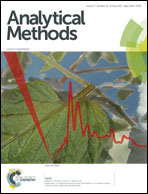Rapid, selective, and ultrasensitive fluorescence ratiometric detection of sulfide ions using dual-emitting BSA–erbium(iii)-modulated gold–silver bimetallic nanoclusters†
Abstract
Dual-emitting bovine serum albumin–erbium(III) complex-modulated gold–silver bimetallic nanoclusters (BSA–Er/Au/Ag-NCs) have been synthesized for the first time by a simple one-pot synthesis route. The BSA–Er/Au/Ag-NCs show unique and well-resolved dual emission bands at 400 nm corresponding to the emission of the BSA–Er complex and 585 nm related to the emission of Au/Ag-NCs under a single wavelength excitation at 340 nm, respectively. Interestingly, with the addition of sulfide (S2−) ions, the emission intensity at 400 nm (I400) increases, while the emission intensity at 585 nm (I585) decreases, which could be due to the formation of an Ag2S layer on Au/Ag-NCs. The Ag2S layer not only quenches the fluorescence of Au/Ag-NCs due to the surface capping phenomenon, but also separates the BSA–Er complex and Au/Ag-NCs. The enlarging distance blocks the fluorescence energy transfer (ET) from the BSA–Er complex to Au/Ag-NCs, leading to an enhancement of the photoluminescence intensity at 400 nm. The opposite effect makes the ratio of the two emission intensities (I400/I585) ultrasensitive to detect the existence of S2− ions. Accordingly, a ratiometric fluorescent nanosensor for the determination of S2− ions was established. Under optimum conditions, the fluorescence intensity ratio (I400/I585) of the nanosensor against the concentration of S2− ions shows a good linear range from 0.02 μM to 180 μM with a lower detection limit of 6.0 nM and excellent anti-interference performance.


 Please wait while we load your content...
Please wait while we load your content...